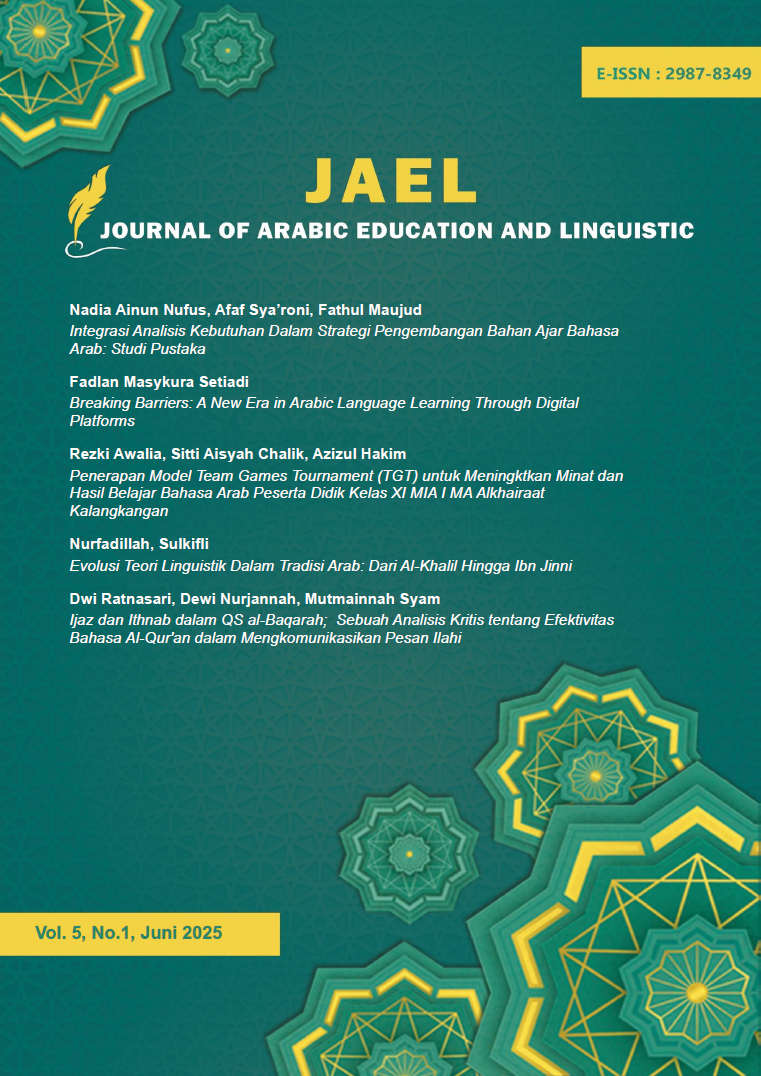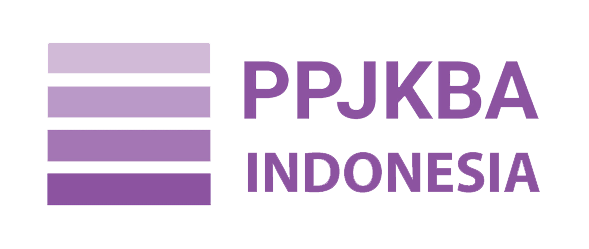Breaking Barriers: A New Era in Arabic Language Learning Through Digital Platforms
DOI:
https://doi.org/10.24252/jael.v5i1.56707Keywords:
New Era, Digital Platforms, Arabic Language Learning,, TechnologyAbstract
This study explored the transformative potential of digital platforms in Arabic language learning, particularly focusing on how these technologies break traditional barriers to Arabic language acquisition. This research employed qualitative research with a type of literature study. The primary sources of data for this study's data on the integration of digital platforms in Arabic language learning were a number of books, journals, websites, and other literary works. Meanwhile, data analysis techniques used the Miles and Huberman model, namely data collection, data reduction, data display, and data verification. The findings showed that the educational paradigm in Arabic language learning has undergone significant shifts towards technology integration. This study also concludes that digital platforms have great potential to break down traditional barriers in Arabic language learning, especially regarding the limitations of conventional classrooms and materials, thereby paving the way for a new era of learning that is more inclusive and accessible.
References
Abdelbary, Asmaa, Livia Panascì, and Cristina Solimando. “Digital Platforms in Teaching Arabic Dialects.” IntechOpen 34, no. 8 (2023): 1–27. https://doi.org/DOI: 10.5772/intechopen.110672.
Al-Abdullatif, Ahlam Mohammed, and Merfat Ayesh Alsubaie. “Using Digital Learning Platforms for Teaching Arabic Literacy: A Post-Pandemic Mobile Learning Scenario in Saudi Arabia.” Sustainability (Switzerland) 14, no. 19 (2022). https://doi.org/10.3390/su141911868.
Albantani, Azkia Muharom, and Ahmad Madkur. “Teaching Arabic in the Era of Industrial Revolution 4.0 in Indonesia: Challenges and Opportunities.” ASEAN Journal of Community Engagement 3, no. 2 (2019). https://doi.org/10.7454/ajce.v3i2.1063.
Arifin, Zainul, Suci Ramadhanti Febriani, and Hendri Yahya Saputra. “Arabic Learning In The Digital Era: Approach In Online System.” Lughawiyah: Journal of Arabic Education and Linguistics 3, no. 1 (2021): 73–82. https://doi.org/http://dx.doi.org/10.31958/lughawiyah.v3i1.2752.
Creswell, John W. Research Design: Qualitative, Quantitative, and Mixed Methods Approaches. 4th ed. Singapore: Sage Publications, 2014.
Dodiya, Raj. “How Can Data Analytics And Learning Management Systems (LMSs) Improve ELearning Courses?” Elearningindustry.Com, 2023. https://elearningindustry.com/how-can-data-analytics-and-learning-management-systems-lmss-improve-elearning-courses.
Fahmy, Sherif. “The New Battleground: Arabic Language And Speech Technologies.” IST Networks, 2017. https://www.istnetworks.com/blog/the-new-battleground-arabic-language-and-speech-technologies/.
getrapl. “Top 10 Personalized Learning Platforms.” 2023. https://getrapl.com/blog/top-10-personalized-learning-platforms/.
Ghani, Mohammad Taufiq Abdul, Mahizer Hamzah, Wan Ab Aziz Wan Daud, and Taj Rijal Muhamad Romli. “The Impact of Mobile Digital Game in Learning Arabic Language at Tertiary Level.” Contemporary Educational Technology 14, no. 1 (2022): 1–18. https://doi.org/10.30935/cedtech/11480.
Ismail, Heba, Nada Hussein, Saad Harous, and Ashraf Khalil. “Survey of Personalized Learning Software Systems : A Taxonomy of Environments , Learning Content, and User Models.” Education Sciences 13, no. 741 (2023): 1–21. https://doi.org/https://doi.org/10.3390/ educsci13070741.
Kerras, Nassima, and Moulay Lahssan Baya Essayahi. “Education and COVID-19: Learning Arabic Language and Perspectives The Electronic Journal of e-Learning” 20, no. 1 (2022): 36–52. www.ejel.org.
Khetarpal, Abha. “Information and Communication Technology (ICT) and Disability.” Review of Market Integration 6, no. 1 (2015): 96–113. https://doi.org/http://dx.doi.org/10.1177/0974929214560117.
Makkouk, Nisrine EL. “The State of Arabic Literacy: Schools and Online Arabic Learning.” ExecutiveMagazine.Com, 2023. https://www.executive-magazine.com/special-report/the-state-of-arabic-literacy-schools-and-online-arabic-learning.
Miles, Matthew B., and A. Michael Huberman. Qualitative Data Analysis: A Methods Sourcebook. Fourth Edi. Arizona State University, USA: SAGE Publications, Inc, 2019.
Mohd Rahimi, Nik, Nurfarahin Nasri, and Siti Samihah. “Promoting Digital Learning Environment in Arabic Language Education: The Use of Animated Video (AV) For Vocabulary Acquisition among Primary School Students.” Ijaz Arabi: Journal of Arabic Learning 4, no. 3 (2021): 548–56. https://doi.org/10.18860/ijazarabi.v4i3.12941.
Murtadho, Nurul. “Digital Resources and Their Use in Arabic Language Classroom : A Mini-Narrative Review” 612, no. ISoLEC (2021): 242–48.
Musawi, Ali Al, Abdullah Al Hashmi, Ali Mahdi Kazem, Fatima Al Busaidi, and Salim Al Khaifi. “Perceptions of Arabic Language Teachers toward Their Use of Technology at the Omani Basic Education Schools.” Education and Information Technologies 21, no. 1 (2016): 5–18. https://doi.org/10.1007/s10639-013-9305-5.
Mustapa, Al Muslim, Mohd Faizulamri Mohd Saad, and Mohamad Zulkifli Abdul Ghani. “Challenges and Expectations of Online Arabic Language Teaching In The Covid-19 Pandemic Era.” Ijaz Arabi: Journal of Arabic Learning 4, no. 3 (2021): 599–609. https://doi.org/10.18860/ijazarabi.v4i3.11997.
Neelakandan, Naveen. “The Importance Of Learning Analytics To Improve The Quality Of ELearning.” Elearningindustry.Com, 2023. https://elearningindustry.com/importance-of-learning-analytics-in-elearning.
Perks, Ben. “The Best Apps to Learn Arabic in 2023.” Preply.Com, 2023. https://preply.com/en/blog/best-apps-to-learn-arabic/.
Poshu, Lokwa. “Educational Technology : Transforming Learning in the Digital Age.” International Research Journal of Educational Research 14, no. 4 (2023): 1–3. https://doi.org/10.14303/2141-5161.2023.273.
Rahmawati, and Suci Ramadhanti Febriani. “Investigating the Problems of Learning Arabic for Islamic Universities in the Era of Covid-19 Pandemic.” International Journal of Language Education 5, no. 4 (2021): 324–36. https://doi.org/10.26858/IJOLE.V5I4.19732.
Rani, Samsuar. A, Zikriati, Aan Muhammady, Syukran, and Banta Ali. “Arabic Language Learning Based on Technology (Opportunities and Challenges in the Digital Era).” International Journal of Education, Language, and Social Science 1(1), no. 1 (2023): 1–11. https://ijelass.darulilmibinainsan.or.id/index.php/ijelass/article/view/4.
Ranjan, Rajeev. “How to Personalize Learning with Data Analytics-Importance, Implementation and Challenges.” Linkedin, September 17, 2023. https://www.linkedin.com/pulse/how-personalize-learning-data-analytics-importance-rajeev-ranjan.
Rasmal, Team. “Learn about 10 Platforms for Online Self-Learning That Support the Arabic Language.” Rasmal.Com, 2023. https://www.rasmal.com/online-platforms-courses-to-learn-arabic-language/.
Ritonga, Mahyudin, Rosniati Hakim, Talqis Nurdianto, and Apri Wardana Ritonga. “Learning for Early Childhood Using the IcanDO Platform : Breakthroughs for Golden Age Education in Arabic Learning.” Education and Information Technologies 28, no. 7 (2023): 9171–88. https://doi.org/10.1007/s10639-022-11575-7.
Rivera, Gabrielle. “10 Free Personalized Learning Platforms.” Edapp, 2021. https://www.edapp.com/blog/10-personalized-learning-platforms/.
Shamigian, Siroun. “Transforming Arabic Language Education: Kamkalima’s Impact Report 2023.” Linkedin, 2023. https://www.linkedin.com/pulse/transforming-arabic-language-education-kamkalimas-impact-shamigian?utm_campaign=articles_sitemaps&utm_medium=google_news&utm_source=rss.
Staff, External Relations. “Online Platform Provides Open-Source Resources to Learn Arabic.” New York University Abu Dhabi, 2022. https://nyuad.nyu.edu/en/news/latest-news/global-learning/2022/february/online-platform-provides-open-source-resources-to-learn-arabic.html.
Team, Al-Fanar Media Reporting. “A Guide to Top Platforms for Online Courses.” Al-FanarMedia, 2022. https://www.al-fanarmedia.org/2022/10/online-courses-learning-platforms-arabic-english/.








